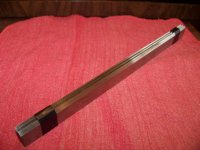Newman109
Diamond
- Joined
- Sep 4, 2006
I have a vintage Parks Wood Planer that I bought and refurbished in 1970. I used it to plane wood for guitar building until about 1977. It performed beautifully and it's been in storage ever since then in my barn.
My son, who also plays guitar, recently expressed some interest in building a jumbo-sized steel string guitar - think Gibson J-200. I said that I'd be glad to help him, sort of a father-son project.
In cleaning up the machine, I noticed that the blades needed some help. they were still in decent shape, except one of the three blades had some notches in it, probably from some embedded metal in a piece of wood for a project sometime in the past. The blades were new at the time that I got the machine and had never been sharpened.
Checking in the yellow pages and online, I discovered that there was no company in my area that specialized in sharpening blades. They are sold on eBay and Amazon and other sites, but they get something like $50 or so for a set of three.
I checked on You Tube and there are lots of methods shown there, some of which I liked, others not so much. The best ones involved grinding on a milling machine.
Being a hobby machinist with a large Webb mill, I decided to see what I could do to set myself up to sharpen them myself, even if I had to purchase some tooling for the project.
That led to the purchase of a small, Chinese-made tilt table that would move to 50 degrees, the same angle as the blades. That was around $100. I also purchased some fine 3" grind stones and a 3/8" mandrel to hold the stones.
Pictures and Notes:
I turned some large washers to secure the blades to the tilt table with T-nuts. I used a dial test indicator to tram the tilt table to the mill table and then the blades to the tilt table.
Grinding was accomplished with the spindle set at 2,000 rpm. The mill will do 4,200 rpm, but I wanted to conserve the stone. I cooled the stone with soluble oil mix in a spray bottle and used successive passes with my X servo, advancing a few thousandths on my DRO for each pass.
The blades came out very nicely and are within .001 width all along on all blades.
Hopefully this will encourage others to DIY.




My son, who also plays guitar, recently expressed some interest in building a jumbo-sized steel string guitar - think Gibson J-200. I said that I'd be glad to help him, sort of a father-son project.
In cleaning up the machine, I noticed that the blades needed some help. they were still in decent shape, except one of the three blades had some notches in it, probably from some embedded metal in a piece of wood for a project sometime in the past. The blades were new at the time that I got the machine and had never been sharpened.
Checking in the yellow pages and online, I discovered that there was no company in my area that specialized in sharpening blades. They are sold on eBay and Amazon and other sites, but they get something like $50 or so for a set of three.
I checked on You Tube and there are lots of methods shown there, some of which I liked, others not so much. The best ones involved grinding on a milling machine.
Being a hobby machinist with a large Webb mill, I decided to see what I could do to set myself up to sharpen them myself, even if I had to purchase some tooling for the project.
That led to the purchase of a small, Chinese-made tilt table that would move to 50 degrees, the same angle as the blades. That was around $100. I also purchased some fine 3" grind stones and a 3/8" mandrel to hold the stones.
Pictures and Notes:
I turned some large washers to secure the blades to the tilt table with T-nuts. I used a dial test indicator to tram the tilt table to the mill table and then the blades to the tilt table.
Grinding was accomplished with the spindle set at 2,000 rpm. The mill will do 4,200 rpm, but I wanted to conserve the stone. I cooled the stone with soluble oil mix in a spray bottle and used successive passes with my X servo, advancing a few thousandths on my DRO for each pass.
The blades came out very nicely and are within .001 width all along on all blades.
Hopefully this will encourage others to DIY.












